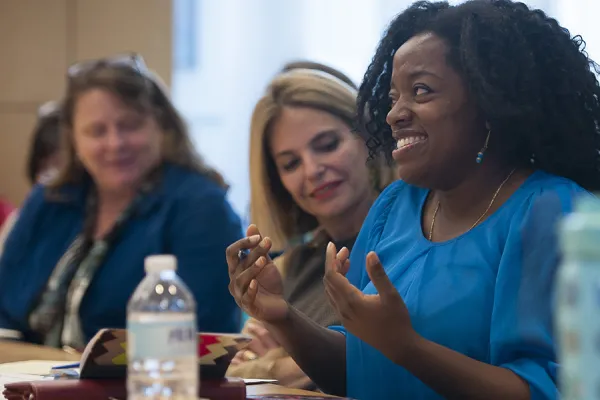Campaign Impact: Support For Courses Without Borders
Supporting Smith

Published March 3, 2017
Important innovations across Smith’s curriculum are strengthening connections among academic disciplines and linking classroom work with real-world issues, all in an effort to reimagine the liberal arts for the 21st century. The goal is to help students develop the intellectual confidence needed to tackle humanity’s greatest challenges.
As the world’s problems become ever more complex, the borders between academic disciplines must be less rigid. Today’s students, for instance, can take interdisciplinary courses on topics like the Flint, Mich., water crisis; climate change; and race, feminism and resistance in movements for social change. The way courses are taught has evolved, too, as more students are learning in “flipped classrooms,” where reading and direct instruction is done out of class so that course time can be spent in collaboration and discussion.
There are new majors, too. Smith is the first women’s college in the nation to offer a major in statistical and data sciences. In courses like Visual Analytics and Communicating with Data, students use their ingenuity to construct compelling data visualizations that help us understand data in exciting new ways. Smith students have put their data skills to the test by competing in the Five College DataFest, in which small teams wrangle insights from a complex data set. In two of the three years it has competed, Smith’s team has won best in show.
Another new major, Middle East studies, allows students to explore the history and culture of a region that has become vital to understanding the world today. The program encourages deep understanding through language instruction, study abroad and strong on-campus programming featuring international leaders like former U.S. ambassador to Syria Robert Ford and Sarah Leah Winston, the executive director of the Middle East and North Africa division at Human Rights Watch.
“The Middle East studies major serves an urgent need for leadership and expertise in one of the world’s most critical regions,” says Steven Heydemann, the inaugural Janet Wright Ketcham 1953 Professor in Middle East Studies at Smith and a nonresident senior fellow at the Brookings Institution.
“The initiative is an inspirational reimagining of the liberal arts in which the humanities, social sciences and STEM disciplines work in synergy.”
Smith’s new academic programs build on existing strengths. Twelve years after the founding of the Picker Engineering Program, the Design Thinking Initiative is incorporating a solution-focused, action-oriented mindset into interdisciplinary courses (blending anthropology and engineering, for example, or art and landscape design). It works with concrete challenges that range from repurposing food waste to developing a sense of belonging in a diverse community.
“The initiative is an inspirational reimagining of the liberal arts in which the humanities, social sciences and STEM disciplines work in synergy,” says Zaza Kabayadondo, co-director of the initiative. “Design thinking can prepare students for creative engagement with the messy and challenging problems facing our world.”
In recent years, Smith has expanded its academic concentrations, which are focused areas of study that require students to dive deep into an area of interest by integrating classroom experience with the world of practice. A growing list of concentration topics includes climate change, poetry, archives, book studies, south Asia, women’s education and global financial institutions.
The concentrations allow some 80 students each year to mix practical experience (often an internship with an experienced mentor) with academic coursework. Kimberly Drew ’12, an art history major with a museum studies concentration, credits her internship at the Studio Museum in Harlem with guiding her toward museum work. She’s now the social media manager for the Metropolitan Museum of Art in New York. She is also known for her own Black Contemporary Art Tumblr page. “I knew that working in museums in some capacity was for me,” Drew says.
Katherine Rowe, provost and dean of the faculty, says Smith’s innovations across the curriculum are giving today’s students the skills and academic preparation they will need.
“We are in a world in which all professions are experiencing change,” she says. “It’s essential that we offer our students the opportunity to make powerful connections among and across disciplines, and to collaborate with leading scholars and peers within and outside the academy. This type of engaged scholarship develops the critical intellectual and collaborative skills—and the sophistication in navigating change—we hope that Smithies will become known for in the diverse workplaces and communities they will lead.”
Zaza Kabayadondo (right) is co-director of the Design Thinking Initiative, part of Smith's ongoing efforts to reimagine the liberal arts.